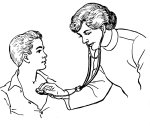Heartbeats


By sean mcnulty
- 143 reads
More had gathered when we arrived at the newspaper and they were – like their Screaming Deane comrades – mostly young, which would be to our benefit as this meant they were not wise to who Oran even was. He rarely left the house so only those in town with long, long memories had ever sighted him. Two other matters might have led to the activists’ failure to recognise the Berrills: firstly, the sheer heft of the man was itself a guaranteed distraction in a town of homunculi, but as well as this he carried an extensive roof over his head in the form of the wild sika stag. The painting was 24x36 inches (no meagre package) and upon getting out of Mr Grant’s vehicle, Oran had opted to walk with it balancing on top of his head in the manner of a Tanzanian washerwoman. The picture was held within a rather thin wooden frame and I feared it might snap apart if one of the protestors got their mitts to it; luckily they were not able to reach Oran’s soaring cranium.
Squeezing past the throng, I experienced a private moment of apprehension and unease. All it took was one or two Gullivers among them as well as a vocal ringleader, a role anybody could occupy in this weather, and we’d have a riot on our hands. I was so very glad when we got to the door of the building and myself and Oran and Mr Grant were able to make it inside without incident.
There was profound disbelief on the faces of my fourth estate colleagues when we got up the stairs. Most working at the paper had memories long enough to recall and identify the king-sized loaf in our presence, even if their eyes were unused to the sight of him; but the man from Dunshaughlin was quite another story. I noted significant alarm in Alison Colreavy’s eyes. Deep down she might have suspected I didn’t really know the notorious siblings at all but this appearance now confirmed my collusion with them.
Lavery must have sensed we had arrived because he showed up suddenly in the doorway of his office, and said, ‘Well, would you ever look at this . . . ?’
Heads tilted back as Oran strode between the desks. No-one had laid eyes on him in years – fifteen at least since he’d shown his face so readily in town. I saw Kerley pick up his camera eagerly as though about to capture a prize-winning portrait of some unidentified creature in the wild, but he was sage enough finally to defer and lay down his weapon.
‘So very nice to meet you,’ said Mr Grant as he approached Lavery. Malachy Grant at your service.’
‘Arthur Lavery. You’re in the business of purchasing works of art, I hear?’
‘Indeed. A unique genre of works, one of which I believe you might be in possession of yourself.’
‘It’s all yours if all’s fair.’
‘And that’s fair.’
‘Fair enough.’
Lavery was prepared for an audience; he had the painting up on his desk for display when we went in. Inchwise, it was much smaller than the stag (about 20x15).
‘What a beauty of apocalyptic invention,’ said Mr Grant, with great enthusiasm. Dubitation fell over Lavery for a moment but he shrugged it off sensing from the way the man from Dunshaughlin looked that he was of an atypical and particular breed.
Oran took a case from the pocket of his track bottoms. It was a tad wider than one you’d have for your spectacles. Inside was the stethoscope.
‘What the hell’s this?’ asked Lavery. ‘Dr Kildare all of a sudden, is it?’
‘For confirmation,’ I explained. ‘He’s able to listen to the cracks on the canvas and say whether it’s a fake or not.’
‘I don’t think mine’s a fake, boyo. The Jesuits brought it here and whatever you want to say about that crowd, you’d hardly call them liars.’
‘That’s for sure,’ agreed Mr Grant. ‘Went to school with them myself. Ad majorem dei gloriam.’
‘What’s that mean?’
‘Do Himself proud. Basically.’
‘They might be sincere folk,’ said Oran. ‘But that doesn’t exempt them from the hook, line, and sinker problem. Plenty of good men, perceptive ones even, have been duped by the wizardry of a fine hoax.’
I was not convinced there was a hoax underway. Now that I could see both paintings in front of me, I felt – from my own admittedly unschooled perspective – that they shared an artist in their respective foundations and it was through the eyeballs this affinity was pronounced. They were remarkably similar in shape, colour, and intensity, and rendered in a more photorealistic style than the rest of the animal. If Montescu’s eyeballs had a function, it was to warp the picture. They looked out of place. You’d think they were stickers from a set given to an ungovernable child who had then employed them in a fit of vandalism.
Then, before our eyes, Oran turned from the land’s most illustrious layabout to an investigator of exceptional grace and deliberation. The care with which he applied the stethoscope to the martlet led me to believe he’d used it many times before, searching long and hard for heartbeats in inanimate objects. I recalled him getting up close to the wall at the Pompadour. What did he mean to get out of that? I imagined he was the kind of person who routinely listened to his neighbours through the walls and that’s where he got his ideas from. Someone once said to me – I can’t recall who – that all the greatest artists were eavesdroppers. So we should turn a blind eye if we catch someone doing it because they could be the next Charles Dickens for all we know. Peeping Toms too.
Alison came rushing into the office. ‘Come quick,’ she yelled. ‘They’re going mad in the street. They’re on top of some fella.’
‘What fella?’
‘Come on,’ she repeated.
The other three were too caught up with their developing transactions, so it was only I who went to see what the commotion was about. Before going downstairs, we stopped at the front window to get an overview of the street. Plenty more heads had come since first we arrived but I couldn’t see any violence per se. Nor the victim Alison had mentioned. The heads of Sue Ellen Deane and Rita Gilgan were now there, which did not encourage peace of mind, and told me more Gullivers were in all likelihood nearby. Then there was a crash downstairs, like someone had fallen through the door. When we got to the top of the stairs we saw at the bottom Jasper Cudden leaning against the wall in the hallway with a book in his hand. He was out of breath. Ida Roche was there too, swiftly acting to put the snib on the door.
‘What’s up with you, Jasper?’ I said to him.
‘Had a run-in with that lot.’ He could hardly speak.
Slowly both he and Ida came up the stairs and when he stepped into the office I could see the book he had was the advance copy of A Sudden Lavender he’d showed me a few weeks back. (Them in the office must have been very rattled with all the bodies we had landing on us today.)
‘This started it all,’ he said, handing me the book.
‘You don’t need to tell this gang here, Jasper,’ I said. ‘We know all about it.’
‘I meant to say – inside the book. Take a look. On the title page.’
I opened A Sudden Lavender. The inside cover had an attractive floral pattern which reminded me of an inner design on a copy of The Three Musketeers I had when I was young but when I got to the page with the title and author and all that, there was a handwritten signature. The first letter was indistinct, sort of looked like a snowman, but it could have been an 8, or a B, or an S. It may also have been an E. In fact, it looked more like an E when attached to the surname which appeared to have two Gs in it, and with that----well, there was only one thing it could have been and that was Ernest Gilgan’s signature, somehow inscribed later than his expiration.
- Log in to post comments
Comments
Ah, how the thot plickens
threads of quicksilver humour strung weblike throughout being drawn in by a master lacemaker. I note the ref to Swift. I's 1.55am and I had to muffle my bursts of laughter. If this response duplicates, (again) well, then you're twice blessed ;)
best
L
- Log in to post comments
Happy to agree with Lena that
Happy to agree with Lena that this is the work of a master storyteller. I'm always really pleased to see another part - thank you Sean
- Log in to post comments


